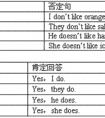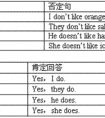My name is Howard. I am from UK. Here is a photo of my school Class Nine, Grade One. The name of our school is Talent Cultivated High School(励才中学). We ar-七年级英语
题文
| My name is Howard. I am from UK. Here is a photo of my school Class Nine, Grade One. The name of our school is Talent Cultivated High School(励才中学). We are learning Chinese in the school. Our Chinese teacher is Jo dong. She comes from Taiwan. Can you see her in the picture? You can see my classmates in the photo, too. Bruce is tall and has black hair. He is good at①volleyball. He’s on the school team. The girl ② a yellow dress is May. She is short and she is good at Maths. Sandra’s hair is long. She can speak French(法语). Joy is a black girl. She has short hair. She likes swimming very much. She is in the swimming team. I like music. Can you find me? The boy with glasses is me. Monica is new here. She is from Macao. She has long black hair and black eyes. ③She speaks English very well, and she is very good at computer. 小题1:根据短文内容在①②处各填一词。 ___________ ______________ 小题2:找出同义句:May is wearing a yellow dress __________________________________________________________________ 小题3:根据短文内容回答问题。Where is his Chinese teacher from? __________________________________________________________________ 小题4:把③译成汉语。 _________________________________________________________________ 小题5:在文中找出文章的标题。 __________________________________________________________________ |
答案
小题1:playing in 小题2:The girl in a yellow dress is May 小题3:She is from Taiwan 小题4:她英语讲得很好,而且还擅长电脑 小题5:Here is a photo of my school Class Nine, Grade One |
试题分析:本文描述了一张班级的合影照,具体介绍了照片中的不同人物,包括中文老师,具体是对同学的详细介绍和对我自己的简单描述。 小题1:is good at doing意为“擅长做某事”;打排球通常用动词play;即play volleyball;in a yellow dress 为介词短语做定语,修饰the girl;故答案为playing in 小题2:May is wearing a yellow dress和短文中的第二段中的The girl in a yellow dress is May意思完全相同;故答案为The girl in a yellow dress is May 小题3:根据第一段 Our Chinese teacher is Jo dong. She comes from Taiwan. 可知,中文老师来自于台湾;故答案为She is from Taiwan 小题4:本句为and连接的并列句,故答案为她英语讲得很好,而且还擅长电脑 小题5:文中的第二句即是文章的主题句;故答案为Here is a photo of my school Class Nine, Grade One |
据专家权威分析,试题“My name is Howard. I am from UK. Here is a photo of my sch..”主要考查你对 实义动词,实义动词的单数第三人称形式,动词短语 等考点的理解。关于这些考点的“档案”如下:
实义动词实义动词的单数第三人称形式动词短语
考点名称:实义动词
- 实意动词:
即行为动词,表示动作的动词。实义动词与系动词是相对的,能独立用作谓语。
它分为及物动词和不及物动词两种:
及物动词是指后面要求有直接宾语的动词;
不及物动词指后面不需要跟宾语的动词。 实意动词使用方法:
及物动词
后面必须跟宾语意义才完整的实义动词,叫做及物动词(transitive verb)。如:
I believe that the committee will consider our suggestion.我相信委员会将会考虑我们的建议。
“How long can I keep the book ?”Harry asked.哈里问:“这本书我可以借多久?”
Dr. Bethune set us a good example. 白求恩大夫给我们树立了好榜样。
Crude oil contains many useful substances.原油含有许多有用的物质。
不及物动词
本身意义完整后面不须跟宾语的实义动词,叫做不及物动词(intransitive verb)。如:
Birds fly.鸟会飞。
It happened in June 1932.这件事发生于一九三二年六月。
My watch stopped.我的表停了。
She spoke at the meeting yesterday evening. 她在昨天晚上的会上发了言。
兼作及物动词和不及物动词
英语里有不少实义动词可以兼作及物动词和不及物动词。这样的动词又有两种不同的情况
a)兼作及物动词和不及物动词时,意义不变。试比较:
Shall I begin at once?我可以立刻开始吗?(begin作不及物动词)
She began working as a librarian after she left school.她毕业后当图书馆管理员。(began作及物动词)
When did they leave Chicago?他们是什么时候离开芝加哥的?(leave 作及物动词)
They left last week. 他们是上周离开的。(left 作不及物动词)
b)兼作及物动词和不及物动词时,有时意义不尽相同。如:
Wash your hands before meals.饭前要洗手。
Does this cloth wash well? 这布经得起洗吗?- 英汉实意动词用法比较:
与汉语的比较,有时英语动词的及物和不及物的用法,与汉语的用法不一样,请注意下列两种情况:
a)有的动词在英语里只能用作不及物动词,而汉语则可用作及物动词,如arrive到达,agree同意,listen听。英语里这些动词后面常接介词。如:
We arrived at the railway station at noon.
我们于中午到达火车站。(at不能省去)
(比较:We reached the railway station at noon.)
Everybody listened to the lecture with great interest.
每个人都很有兴趣地听讲课。(to不可省去)
(比较:We all heard the lecture.)
Do they agree to the plan?他们同意这个计划吗?(to不可省去)
b)有的动词在英语里能用作及物动词,而在汉语里则不能用作及物动词,如serve为…服务。
Our children are taught to serve the people wholeheartedly.
我们的儿童被教以全心全意为人民服务
用于be动词之后,实义动词之前。 实意动词的用法:
肯定句:
主语+动词过去式+其它
否定句:
主语+助动词didn‘t+动词原型+其他
一般过去式:
Did+主语+动词原型+其他
考点名称:实义动词的单数第三人称形式
在一般现在时的肯定句中,当主语为非第三人称单数时,谓语动词用原形;
当主语为第三人称单数时,谓语动词用单数第三人称形式。- 实义动词的一般现在时的单数第三人称形式遵从“s,es, ies”六字母规则。如下表所示:


![How much does it ______ to fly from Yancheng to Hainan Island?[ ]A. cost B. payC. spend D. take-七年级英语](http://www.00-edu.com/d/file/ks/4/2/shiyidongci/2020-01-05/small7dcf2f05998de63e10cc3629787031c81578210087.png)

![He always _____TV in the evening. He _____ listening to the radio. [ ]A. watch, don't like B. watches, doesn't like C. watching, don't like D. watch, do-七年级英语](http://www.00-edu.com/d/file/ks/4/2/shiyidongci/2020-01-05/small45d599b4a60b84e61cec210bfbf051f51578214524.png)
![I'd rather ___ to the Mcdonald's Restaurant because I like to listen to quiet music.[ ]A. to go B. going C. go D. went-八年级英语](http://www.00-edu.com/d/file/ks/4/2/shiyidongci/2020-01-05/small1767bba1727fef2c035c53dcbd9bc20e1578209517.png)
